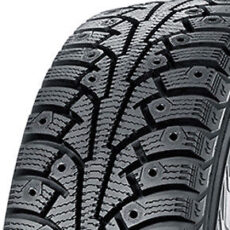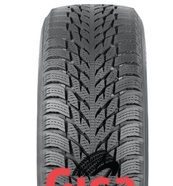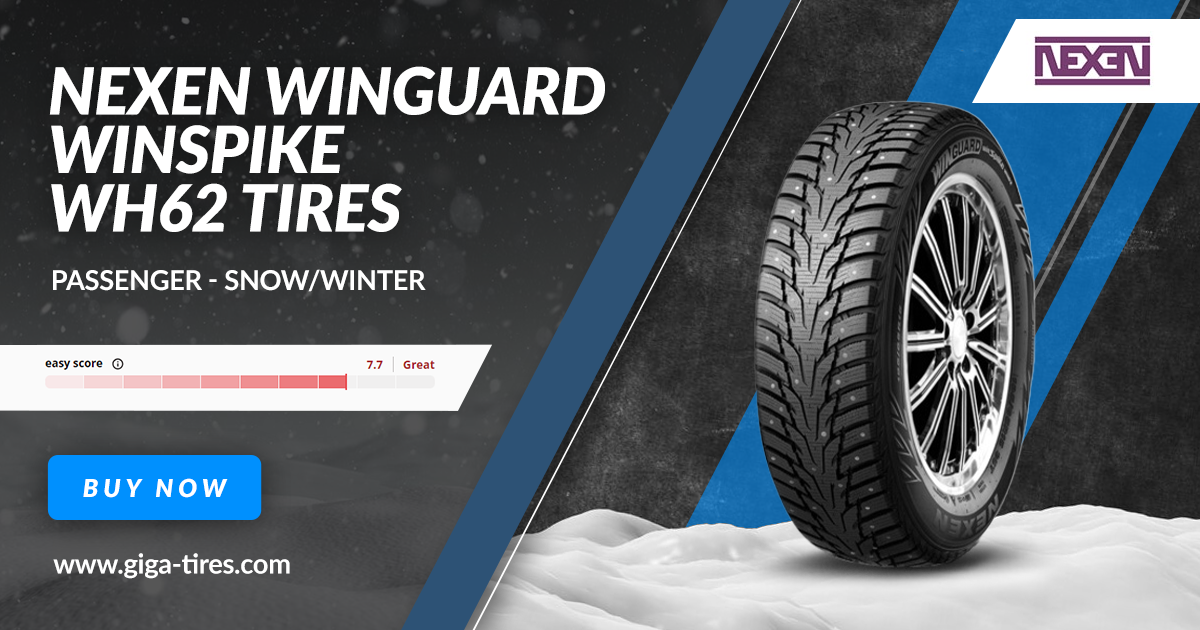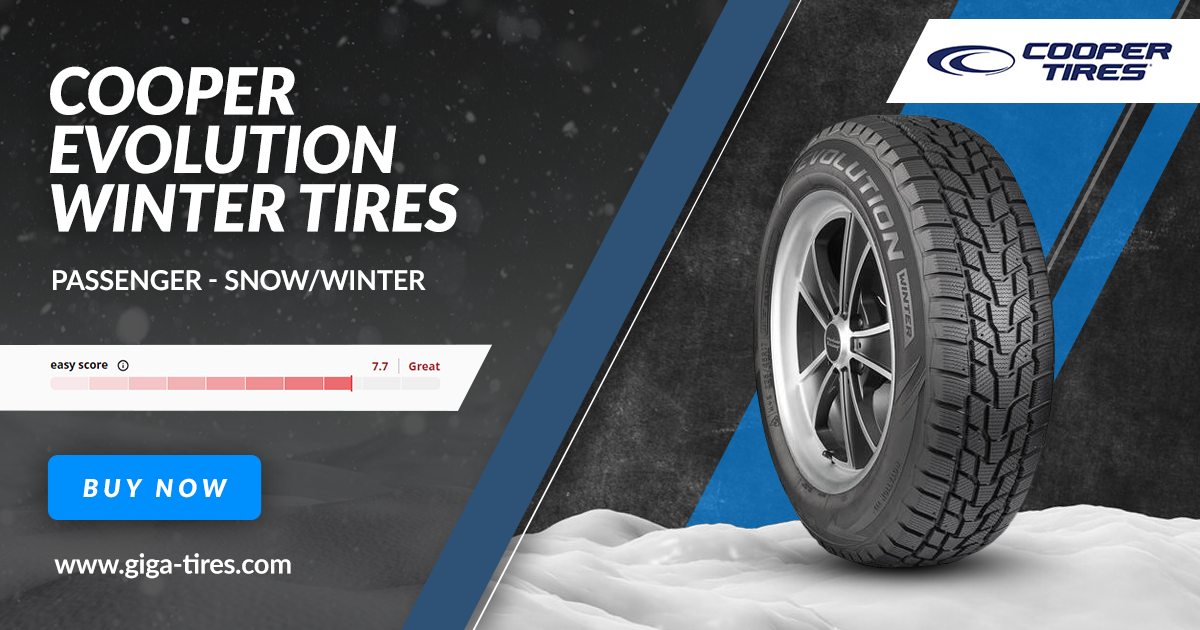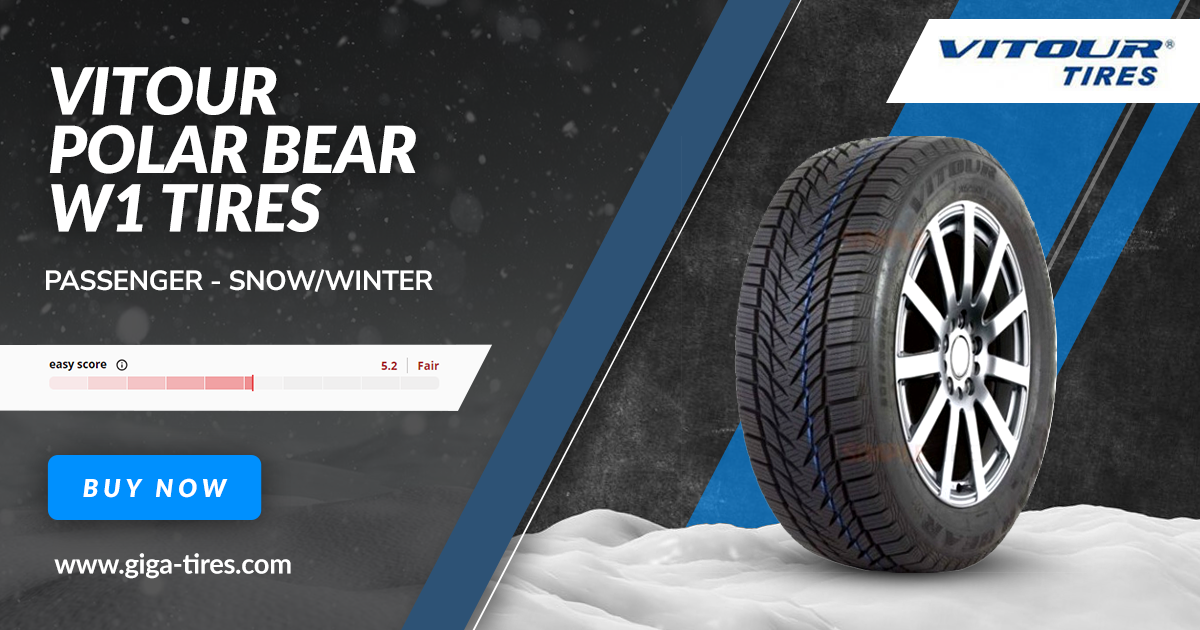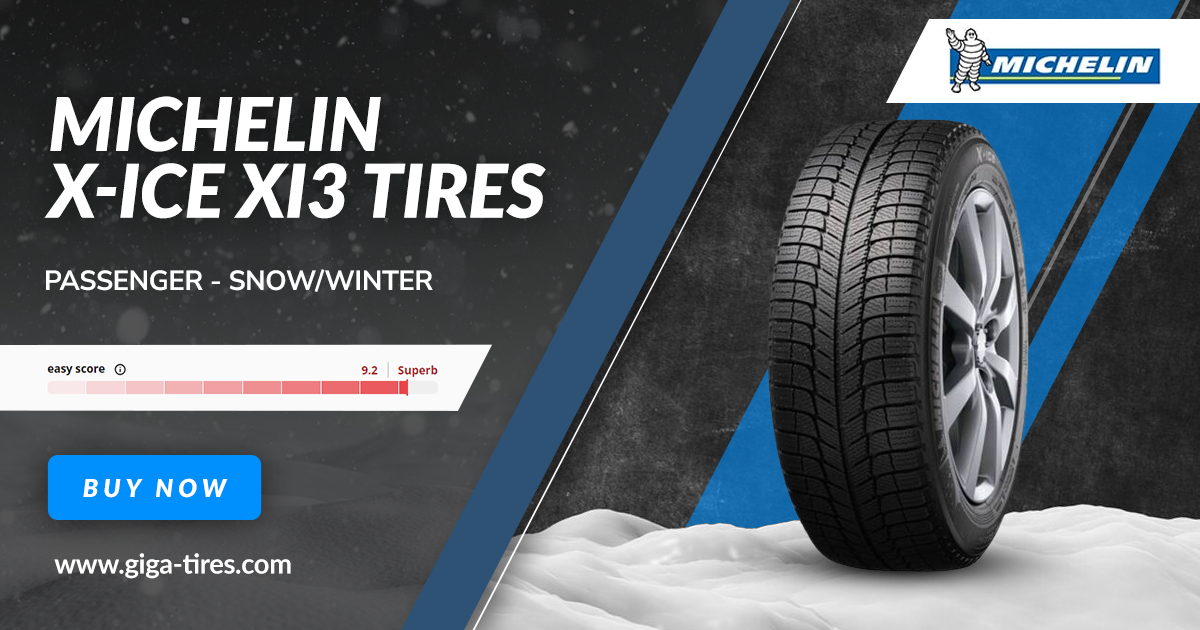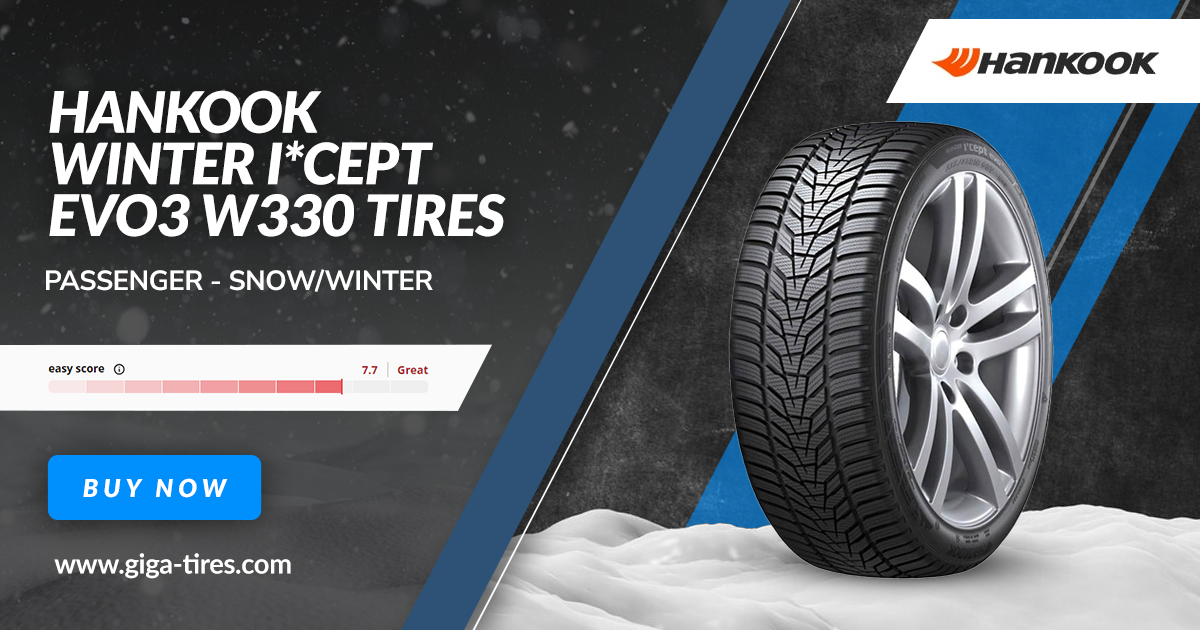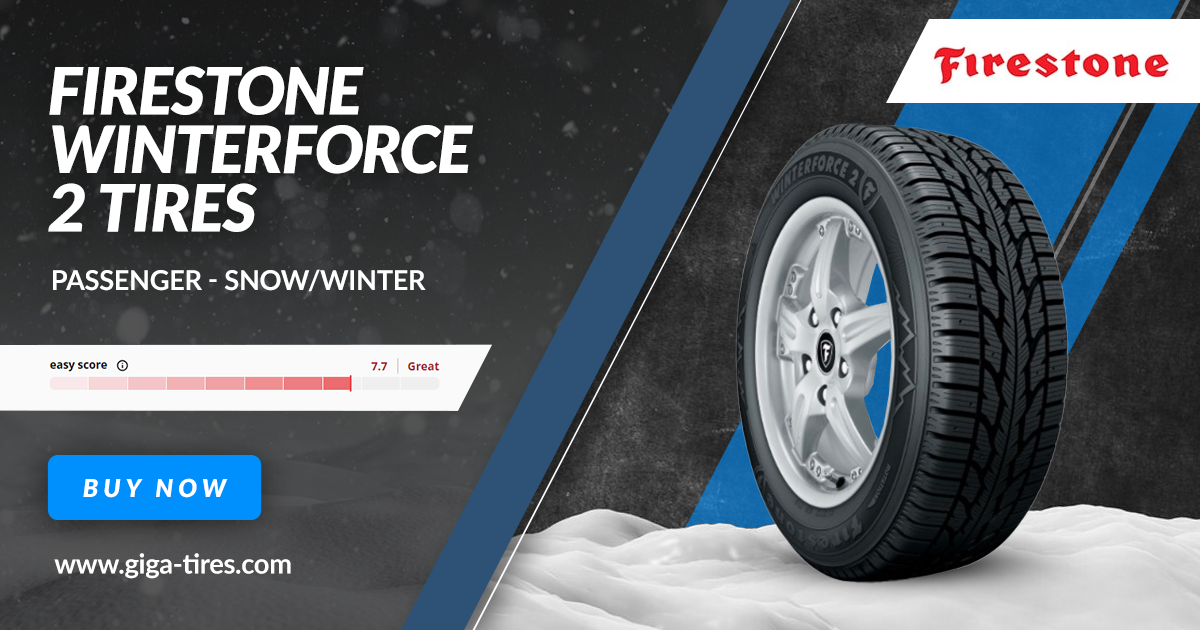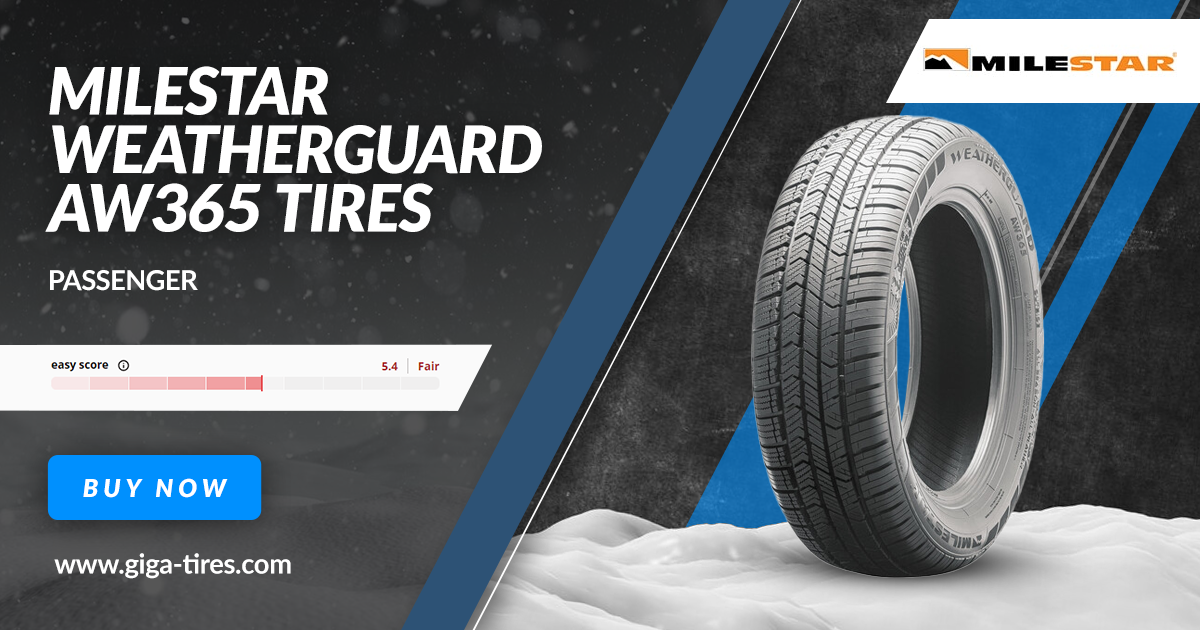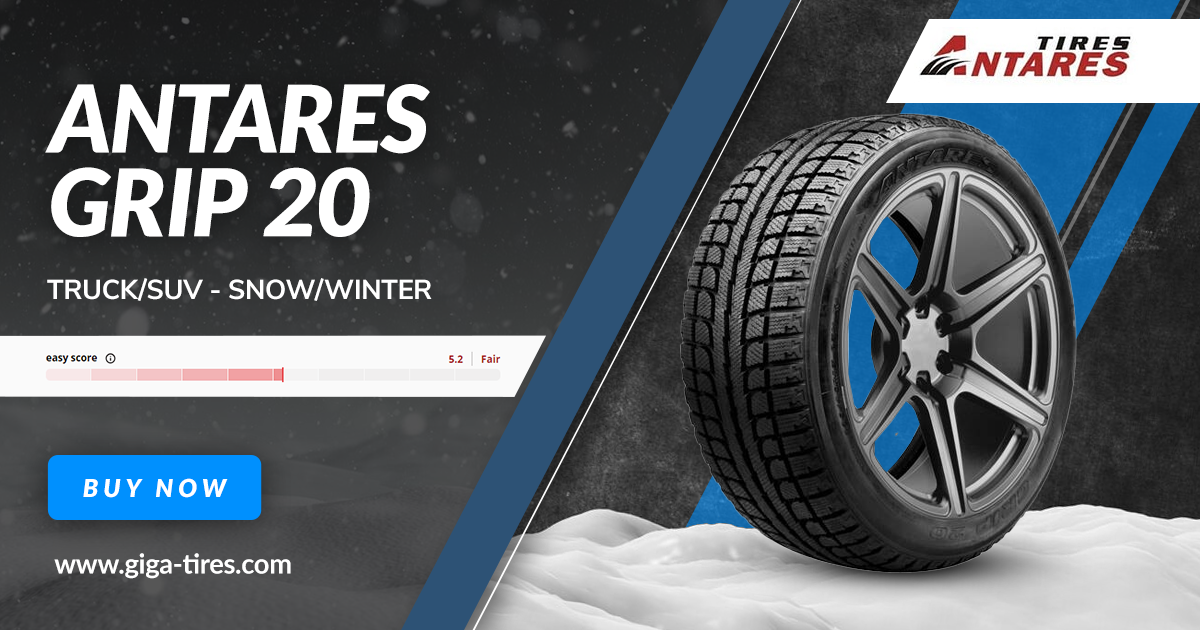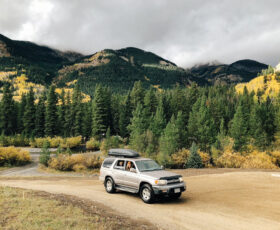Last Updated on 4 months
Your Comprehensive Guide to Winter Tires: Benefits, Selection, and More
Winter is around the corner. As much as we all love the holidays, eating delicious food, sipping hot chocolate, and devouring snowman-shaped cookies, the cold season has its fair share of difficulties – perhaps none more significant than driving on snow-covered/icy roads!
This can be especially difficult if you travel long distances to see family. You need to make sure you’re taking extra precautions to ensure your safety on wintry roads. When navigating snowy or icy roads, investing in a good set of winter tires is the best thing you can do.
Considering your current good head start, it’s probably time to look into winter snow tires. Winter tires are crucial for all drivers who experience cold/snowy weather. You don’t always have to break the bank to get them!
Keep reading this comprehensive guide to learn everything about buying your first set of winter tires, including what the different kinds are, how much they cost, what to do with winter tires in the summer, and why weather-specific tires are crucial for everyone’s safety.
What Are Winter Tires?
First things first: before diving into the best tires for snow and the different aspects of winter tire ratings, we need to explain what winter tires are adequate.
Winter tires are designed to maintain good traction on snowy, icy, and slushy roads in extreme cold temperatures. The rubber construction of the tire is meant to stay flexible and has deeper tread depths and unique tread designs to grip treacherous winter roads better.
You’d be surprised how many people don’t know the difference between all-season and winter tires.
Data About Crashes Due to Snow and Sleet
Although many have heard of snow and winter tires before, they often consider the vehicle’s benefits before considering how impactful they can be to other drivers on the road.
Between 2007 and 2016, there were over 1.2 million weather-related crashes, and roughly 18 percent were due to snow and sleet alone. Another 13 percent can be attributed to the icy pavement, and 16 percent to the snowy or slushy pavement.
Remember that over 70 percent of America’s roads are in snowy regions. It’s widespread for people to spend their winters driving on snowy or slushy streets, and over a thousand people are killed annually in these conditions.
Some other winter crash statistics include:
- Over 116,800 people are injured annually in vehicle crashes on snowy, slushy, or icy pavement.
- Roughly 70 percent of accidental deaths in the wintertime happen in automobiles.
- About 900 people are killed in crashes during snowfall or sleet every year.
The price of winter tires is small compared to the level of safety they provide on the road, with the right kind of grip and traction for winter conditions.
What You’ll Learn in This Winter Tires Guide
In this guide, we plan to cover many topics concerning snow and winter tires. We’ll tackle issues such as:
- All-season vs winter tires
- When to install or put on snow/winter tires
- Snow tires in the summer
- The average winter tire cost
- How to choose winter/snow tires
By the time you’re done reading, you’ll know everything there is to know about winter tires and why they’re essential. Additionally, you’ll feel equipped with enough knowledge to buy your own set of new winter tires for a decent price.
Why Can’t Regular Tires Handle Snowy Conditions?
If you’re wondering why regular tires can’t handle snow, ice, sleet, or slush very well, look at the tires’ tread patterns. Standard tires don’t have tread patterns designed to keep their grip on ice and snow.
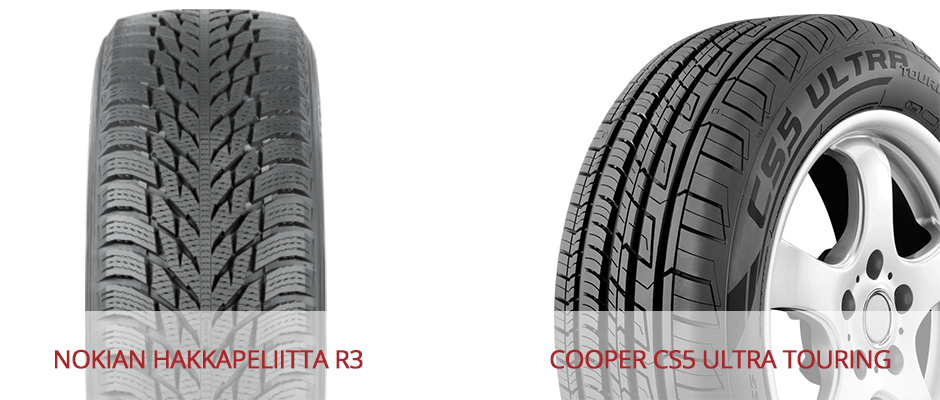
How Much of a Difference Do Winter Tires Make?
According to a recent Michelin survey, about 67 percent of respondents don’t believe they need winter tires as long as they have all-season tires.
However, the Tire and Rubber Association of Canada has found evidence to support the following claims:
- Winter tires can actively help prevent collisions and fatalities on the road.
- Winter tires can reduce costs associated with hospital emergencies and emergency responses during the winter.
- Winter tires can lower insurance payouts, both in size and frequency.
- Winter tires can reduce traffic congestion during the cold months.
Furthermore, it’s been found that winter tires can decrease braking distance in wintry conditions by up to 35 percent. This gives you much more time to react to dangerous situations on the road and protect others (and yourself) from harm.
The Unique Rubber of Winter Tires: What Sets Them Apart
One of the most significant factors that make cold-weather tires different from regular tires or all-season tires is that they are made of another type of rubber. You might not be able to tell with the naked eye, but winter tires have a particular kind of rubber that makes them work differently.
Regular tire rubber hardens as temperatures drop, making it challenging to stay safe and grip the road. Most tires begin this process when the weather drops below 45 degrees Fahrenheit (7 degrees Celsius), which it does in most parts of America for at least some part of the year.
Snow/winter tires, on the other hand, are made of a unique rubber that stays flexible during cold weather to grip the road better. Although this does provide more safety, it has a drawback: this flexible rubber softens and wears out faster than all-season tires.
Many people already resist facing the price of snow tires, and they’re even less impressed when they realize that they don’t last as long as all-season tires. However, even cheap winter tires can maximize your safety and make a huge difference when driving in dangerously cold weather.
Also, this flexible rubber will last long enough if you only drive your winter tires during the winter. Don’t waste the unique material on summer roads, even if switching back to your all-season tires at the end of the winter months is a pain.
Understanding the Difference Between M+S Tires and Winter Tires
In the 1970s, the M+S marking was introduced to help consumers understand which tires had extra mud and snow traction. Although the tire might have met the standard for that period, it might not be today.
Still, we now use the M+S certification system as a benchmark for determining if a tire even has a basic level of snow traction. We’ve evolved beyond that system (as most all-season tires these days have the M+S rating), but it served as a great starting point for designing and evaluating winter-specific tires.
In the 1990s, the Rubber Manufacturers Association (RMA) updated the standards to differentiate between “winter tires” and standard “all-season tires.” The Three Peak Mountain snowflake on the side of a tire is the best indicator that it’s indeed intended for use in the harsh winter months.
Difference Between Winter Tires and All-Season Tires
When people hear that their regular tires are “all-season tires,” they instantly think that the claim is valid: the tires can handle ANY season. After all, that’s what the name implies.
Now, we don’t want to discredit all-season tires. Technology has come a long way in making these tires incredibly effective. However, navigating severe snowy and icy roads requires a tire that was specially designed for winter, not a tire developed to be versatile. That’s where the difference between snow tires and all-season tires comes into play.
All-season tires can work adequately in wintry conditions, and the newer the tires are, the more likely they have improved technology to help with this. However, they are a jack-of-all-trades option, which means that winter tires are more specially designed to handle severe conditions safely.
Think of it this way:
- What kind of shoes would you want for hiking up a snowy hill?
- Sure, your tennis shoes might get the job done, but you’d be much better off with a nice pair of winter boots. The chances of you slipping and falling in your tennis shoes are MUCH more significant than they would be with winter boots.
- The same concept applies to tires.
- Snow or winter tires are designed uniquely to handle the roads in harsh, snowy, and icy conditions. Regular tires are not fully equipped for the extreme challenges, even if they say they’re “all-season.”
The Big Differences
Let’s break down the most significant differences between winter tires and all-season tires.
Rubber composition
Winter tires have flexible rubber components that don’t harden when cold, while all-season (or regular) tires generally do not. Therefore, your tires can constrict and set when you need them to stay pliant and grippy.
Tread depth and pattern
Winter tires typically have a deeper tread and are more specifically designed for removing moisture and making contact with the ground than regular tires. All-season tires have average tread depth and patterns.
Sipes
The tread patterns are designed to be deeper to remove moisture, but they also have sipes or little slits in the tread acting as biting edges to grip the ground in snow and ice. Regular tires have less siping and, therefore, less grip.
How Do Winter Tires Work?
When browsing the winter tires for sale, you’ll likely want to check out the unique tread immediately. As we said, winter tires grip the road with special, flexible rubber and unique snow tire tread patterns.
Now, we’ll dive deeper into this explanation for those winter drivers.
Summer tires typically have solid ribs that are separated by wide circumferential ribs. However, many newer styles have changed from the smooth, solid rib model and added sipes and enhanced tread patterns. Most importantly, the compounds in summer tires freeze and harden in colder temperatures. This is no bueno what you want when dealing with cold weather and potential snow and ice.
Winter tires have something called “high sipe density.” When a tire stays flexible, the sipes open as it rolls, and the two edges bite the snow/ice. As winter tires are designed to stay flexible in cold temperatures, the high density of the biting edges provides added traction for stable acceleration and braking.
These are commonly designed in a zig-zag at angles that oppose the tread pattern for enhanced grip.
In the image above, the sipes run across the tread and are positioned in a way that will help control forward motion and acceleration, grip while driving, and aid in braking. While the track has varied angles and edges designed for traction, the sipes work in a way to provide enhanced stability.
When to Put on Winter Tires
Although winter tires work best in certain cold conditions, you should install them before you hit that first patch of ice or see the temperatures plummet to the teens. As soon as you know the temperature moves into the low 40s, switch your tires out so the winter tires can do their job before it’s too late.
Remember that winter tires aren’t just a good choice for drivers who face snow and ice regularly. They’re also just safer for cold, dry pavement. As we said before, cold temperatures alone (without adding moisture) can cause other types of tires to harden and lose their grip on the surface.
Depending on where you live, you may need to install your winter tires as early as September or as late as November. It just depends on the climate and how quickly the temperatures drop.
Also, remember that winter tires aren’t just for getting better traction on snow; they help with cold weather conditions like ice, sleet, or slush.
Different Types of Snow/Winter Tires
Traditional Snow Tires
“Traditional” snow tires are not generally produced these days. Traditional snow tires were focused on delivering excellent traction on snowy roads. They retained good traction and balanced performance on snowy roads and usually had a combination of big lugs or tread blocks to bite into deep snow; however, they did not perform spectacularly on ice or in extreme cold temperatures.
Modern High-Tech Winter Tires
Technology has helped winter tires more efficiently traverse snow, ice, and freezing dry roads. Modern winter tires have engineered rubber compounds, highly specialized tread patterns and grooves, and high sipe density in the tread to perform in all sorts of wintry conditions—snow, ice, freezing temperatures, etc.
The sipes can be technologically engineered to produce the highest grip on winter roads. You will even see such features as fuel economy, quiet ride, ride comfort, and styling as features of new winter tires. Not only do high-dollar winter tires have these features, but
Even the lower-priced, entry-level tire brands have good technology being engineered into them to provide drivers with safety and dependability. Many traditional and newer high-tech tires come “pinned for studs,” meaning they can have studs added if desired. We’ll discuss what studs can do for your vehicle later.
Winter Tire Safety Tips
When driving with winter-specific tires, you should take specific steps to ensure your safety on the road. These steps will decrease your chance of a wreck, even if you’ve installed cheap winter tires after hours of browsing snow tire reviews.
Tip #1: Check Your Tire Pressure Frequently
Although most modern vehicles will now tell you when your tire pressure is off, double-checking the pressure regularly is a good idea. Find your vehicle’s recommended pressure level, then fill your tires accordingly whenever necessary.
Remember that cold weather tends to make tire pressure change more often, so your tire pressure light may come on several times during the winter when the temperatures drop. For every 10-degree drop in temperature, tires typically lose about a pound per square inch of tire pressure.
An underinflated tire can cause your tires to wear out quickly and cause irreparable damage. That’s the last thing you want to deal with when tackling slippery or icy roads.
Tip #2: Brake Slowly
Even if you’re driving with studded snow tires, you must brake slowly, especially when taking turns on the road. It would be best to wait until you’re done turning before speeding up again.
To avoid braking suddenly on the roads, leave extra room between your vehicle and the one in front. Remember to double your space between other cars in wet conditions and triple it in snow.
Remember that freeway speeds are often reduced up to 13 percent in light snow and 40 percent in heavy snow. In wintry weather, people drive differently (and brake differently), and you must adjust your driving habits accordingly.
Although driving and braking more slowly does lower your chances of getting into an accident during the winter, remember that you’re not the only one on the road. Others can still drive too fast or recklessly, so you need tires with great traction and excellent driving habits.
Tip #3: Install Winter Tires on All Four Wheels
You might think that putting cheap snow tires on at least two of the wheels is better than nothing, but regardless of what kind of performance tires you choose, it’s always best to put them on all four wheels. This will ensure that your car stays balanced, even during bad weather.
Mixing your tires between brands or seasons increases your chances of skidding or sliding. That’s the last thing you want to worry about on a road that’s already slippery.
Tip #4: Check Your Tread Depth Often
Without adequate tread, your chances of hydroplaning increase dramatically. All winter or regular tires should offer enough tread depth to provide road traction during cold weather.
Although you can check your tread depth independently, talking to professionals is also brilliant if you’ve had your tires for a while. They can advise you on when to change winter tires so that you always have enough traction.
Tip #5: Don’t Forget to Rotate Your Tires
Regular tire maintenance doesn’t stop just because you have special winter tires. Tires should still be rotated at least every 6,000 miles. Otherwise, they can wear unevenly, and that can cause problems for even the sturdiest tires during the winter months.
The Best Snow and Winter Tires
Here at Giga Tires, we encourage you to choose the best snow and winter tires for your particular circumstances. That’s why we’ve rounded up some of the best traditional and high-tech winter tires on the market.
Look at the two lists of the best winter tires below to learn how our top contenders vary. Remember: not every vehicle benefits from the exact winter tire, so pick the best snow tires for your specific car and circumstances.
The Best Winter Tires on Giga Tires
1. Nokian Hakkapeliitta
There are various styles of Hakkapeliitta. It’s a premium snow tire in studded and unstudded versions in select sizes. It’s also known as one of the most comfortable, fuel-efficient winter tires you can install (compared to all-season tires).
Price: This tire can be as low as $65 per tire, which is remarkable for such a competent, fuel-efficient winter tire option.
2. Nexen Winguard Winspike
Like the Nokian Hakkapeliitta, Nexen has similar winter tire styles, depending on the size you need. To narrow your options, enter your tire size and see which of the Nexen Winguard Winspike winter tires is right for you.
Price: This tire typically starts around $50, which is pretty low for a winter tire of this caliber and ability.
3. Cooper Evolution Winter
This option is another mid-range studded tire with a traditional winter tread design and compound. Surprisingly, the tire is studded and aggressive yet relatively quiet. The Cooper Evolution Winter offers excellent braking capabilities and a smooth, safe ride during wintry weather.
Price: This tire typically starts around $71, a fantastic value considering the tire’s capabilities and popularity.
4. Vitour Polar Bear
One of the cheapest winter tires available, the Vitour Polar Bear, has outstanding traction and wear life if properly maintained. You won’t have Due to its water evacuation capabilities and directional tread design, you worry about accelerating with this winter tire due to its water price typically starting around $55, which is a fairly average price, especially for a tire with great acceleration and wear life.
The Best High-Tech Winter Tires on Giga Tires
1. Michelin X-Ice Xi3
This tire provides maximum protection in winter conditions and is often used for off-roading. Surprisingly, it also offers excellent fuel efficiency and wear life. You can trust that the Michelin X-Ice Xi3 will get you where you need to go, even when it’s snowing or sleeting.
Price: This tire typically starts around $98, a decent value for a tire with stellar reviews and excellent fuel efficiency.
2. Hankook Winter I-Cept
The Hankook Winter I-Cept offers high-tech features similar to those of brands like Michelin and Bridgestone, but at a more affordable cost. Their asymmetrical tread pattern provides excellent traction for any vehicle, from a family sedan to a fancy sports car.
Price: This tire typically starts around $55. It undoubtedly has excellent reviews and capabilities for this price range.
3. Firestone Winterforce 2
The Firestone Winterforce 2 features an aggressive directional tread pattern, which gives it excellent traction in snow and ice. It’s also reasonably low-priced, considering the tire’s value and safety. It’s like buying a premium tire without the huge price tag attached!
Price: This tire can start as low as $54, making it a well-priced tire with exceptional value.
4. Milestar Weatherguard AW365
This tire incorporates the latest tread design technology with an advanced silica-rich compound. The result is a tire that is reduced in noise, has excellent tread life, and can handle all snowy conditions.
Price: This tire starts at $60, a bargain, given the added value!
5. Antares Grip 20
This tire is surprisingly affordable, considering its hundreds of biting edges in the tread’s center ribs and shoulder block. This pattern makes the tire easily through deep snow and slush.
Price: This tire also starts at $60, making it an excellent choice for drivers looking for a bargain.
Please contact us anytime to learn more about the tires listed above. We’ll help you understand which tire best fits your vehicle and lifestyle, depending on where you live and your budget.
We know you want to find the best value when buying cheap tires, and we’re here to help you do just that!
Conclusion
If driving in snow and ice is a regular occurrence for you during winter, now is the perfect time to start looking into winter tires. It would be best if you were always prepared to switch out your tires to tackle the road safely and confidently.
Refer to this guide to help answer your questions about winter tires and pick the right product for your vehicle! By learning more about driving in the winter and using the right kind of tires, we can all help prevent cold-weather-related accidents and keep our cars in top condition.
Winter tires are crucial in keeping you safe during the colder months. In this comprehensive guide, we’ve covered everything you need to know about winter tires, from their purpose and necessity to the significant difference they make when driving on icy roads. Don’t compromise safety – equip your vehicle with the right winter tires.
Ready to ensure your safety on winter roads?
Head over to Giga Tires today to explore our wide selection of winter tires. Make the smart choice for your winter driving needs, and trust Giga Tires to provide you with the required quality and performance.
Your journey to safer winter driving starts here! Our knowledgeable team at Giga is always happy to provide guidance. Please do not hesitate to get in touch with any questions or concerns!
Take a deeper dive into tire know-how! Please explore our website, Giga Tires, for a wealth of articles that will keep you informed.
- Spotlight On GBC ATV Tires: The Admirable Innovation In ATV & UTV Tires
- Spotlight On Cars And Trucks/SUV Tires: Admiring The Most Common Types Of Tires
- Cheap Tires: How To Get The Best Value When Buying
FAQs
What are winter tires?
Regardless of how cheap or expensive the winter tires are and whether they’re studded, they are made to help drivers stay safe in cold weather conditions. The rubber remains soft and flexible, which allows the tire to conform to the road when temperatures plummet.
Additionally, exceptional tread depths and designs ensure excellent snow, ice, slush, and rain traction.
Can I use winter tires all year?
Technically yes. However, we don’t recommend using winter tires year-round. Here’s why.
The flexible rubber tread of winter tires grips the road extra well during cold temperatures. During the summer, this flexibility isn’t needed on the warm, dry pavement and can reduce your vehicle’s performance.
Although nothing terrible will probably happen if you use winter tires year-round, they will wear down faster – meaning you’ll have to replace them quicker. Additionally, they could compromise your vehicle’s gas mileage on the road during the warmer months, and no one wants that!
What’s the difference between snow tires and winter tires?
In the industry, we call them “winter tires.” However, many consumers start their tire search with “snow tires,” not realizing it’s a somewhat outdated term. The original snow tires handled snow well, but didn’t function as well on ice or freezing dry roads.
Snow tires had super aggressive treads designed to cut through snow with big lugs and deep, wide grooves. The downside was that the tires would harden in colder temperatures, struggle to perform on ice, and be uncomfortable to drive on. Safety was the primary design objective.
Technology and tire designs have improved significantly in recent years to tackle all sorts of wintry conditions. Winter tires generally have more closed tread patterns built to stay flexible in colder temperatures and project biting edges to grip ice. All in all, winter tires are made to handle all winter conditions adeptly – not just snow.
How much do winter tires cost?
You might be surprised by their affordability if you expect to pay an arm and a leg for winter tires. Yes, they’re still expensive, but not out of range for most people who desperately need them during winter.
On average, you can expect to pay anywhere from $50 – $120/per tire for passenger car tires and $70 – $180 for truck and SUV tires. Installation fees will be an additional charge and vary per installation shop. Depending on how much you drive, how much wear you put on the tires, and the original quality and mileage warranty of the tires you purchased, you can get 3 to 5 seasons out of a set of winter tires.
How many winter tires do you need?
Although we’d love to tell you that you can save some money by installing only two winter tires on your vehicle at a time, that isn’t the case. Any tire installer will tell you that you must establish four winter tires at a time to keep your vehicle safe and balanced.
It doesn’t matter if you have a car with four-wheel drive or two-wheel drive – you need to invest in those extra two tires to accelerate and brake without concern.
Additionally, it would be best not to use multiple kinds of winter tires on your vehicle simultaneously. Their tread depths and patterns could vary, leading to an uneven driving experience and other problems.
Are winter tires necessary if your vehicle has traction control?
If you have a relatively new car, you might notice it has extra traction control. This makes people wonder if they need winter tires for that additional traction during the winter months.
The answer is yes; you still need winter tires if facing snowy or icy road conditions. Although you might have extra traction, your all-season tires still don’t have the same capability to handle the extremely low temperatures and icy roads appropriately.
Are winter tires noisy?
This answer depends somewhat on the brand and tire you select. Some winter tires are noisier than others, and some are hardly noticeable. If noise is important to you, consider winter tire reviews that mention sound.
Keep in mind that stable models are often noisier than options without studs. The studs claw the ice, which can be loud and potentially leave scratch marks on your driveway and roads.
How do you store winter tires?
When determining how to store winter tires for your vehicle once spring rolls around, ensure you can put them somewhere cool and dry. Sunshine and moisture can cause them to experience damage, which could make the winter tires unsafe to use next season.
This often means you should not store your winter tires in a moist basement or a hot attic. However, if the area doesn’t receive lots of direct sun exposure or freezing/blistering temperatures, you can most likely store your tires there for months. Many customers put their tires in winter storage bags in their garage to protect them from sun damage and keep moisture away from the tires.
Where can I buy winter tires for a reasonable price?
When deciding where to buy winter tires, we recommend starting with us. At Giga Tires, we have a wide selection of tire brands from all over the country and do our best to give you a comprehensive look at the pros and cons of many different winter tires.
Additionally, we make it easy to compare prices between different snow tires for sale so you can feel confident that you’re getting the best deal.




